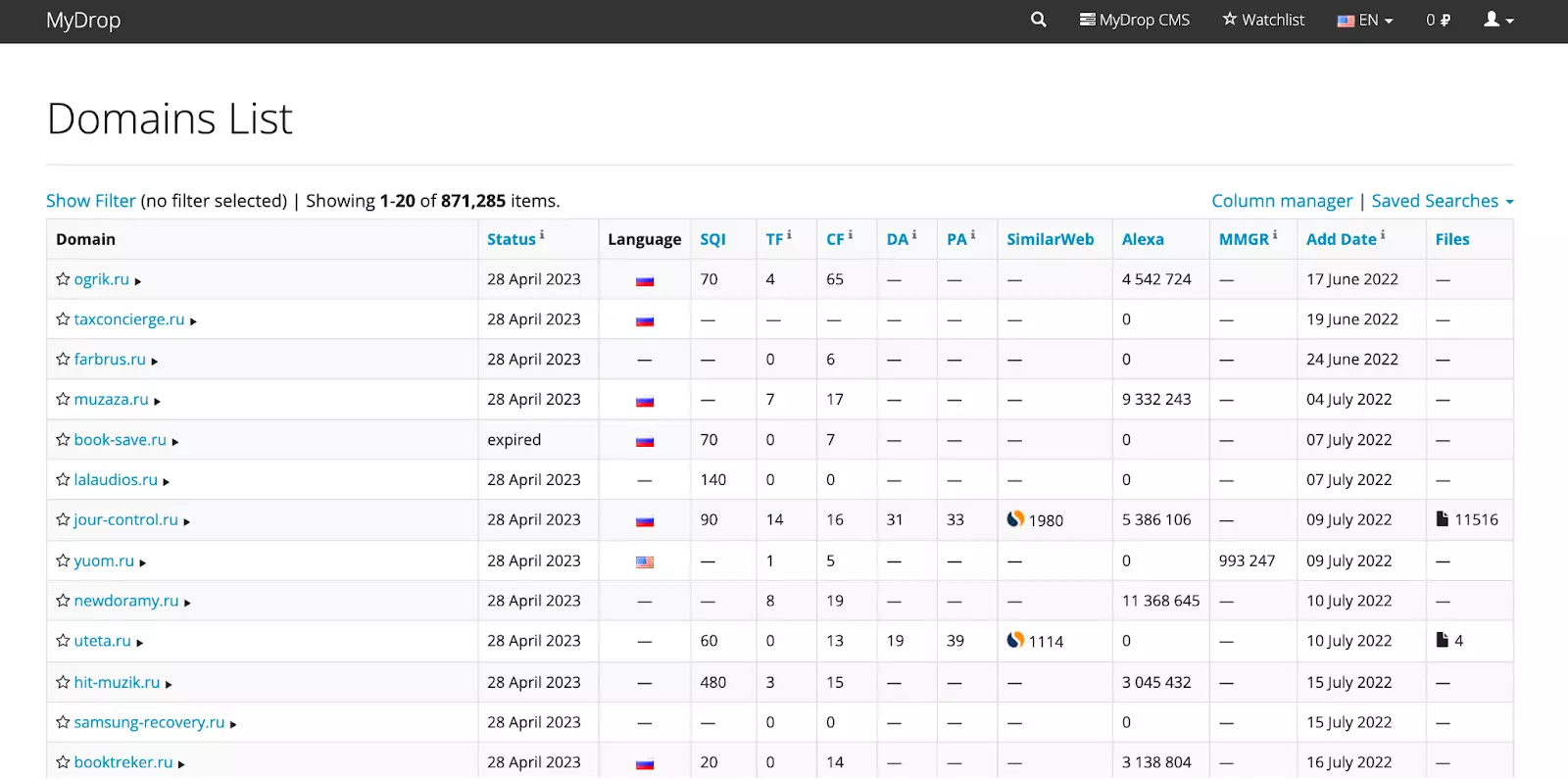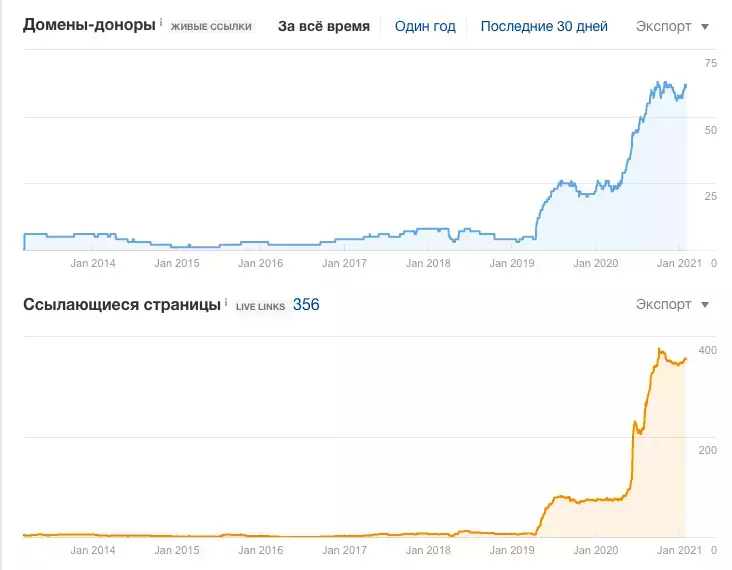

by Editor
SEO traffic in affiliate marketing is considered (and is) the highest quality and most relevant. CPA networks are ready to pay well for it, since a user who "came by himself" on a targeted request often converts to additional sales. If you decide that SEO is great for you as a traffic source, then at the beginning you should definitely study the concept of drop domains and their benefits in generating traffic to CPA offers.
What is a drop domain and why is it needed
A drop domain is a domain that has expired. The reasons can be completely different: the business closed and the site was simply blocked, the site owner forgot to renew the registration or simply did not want to do it, in the end, the webmaster could simply be drafted into the army, and he could not renew the registration physically. But how can an abandoned domain be useful in terms of promotion?
- A drop domain can simply have a beautiful and sonorous name that you can keep or use for resale.
- A domain can have a long history of registration and your site does not have to sit in the sandbox of a search engine.
- A drop can have excellent link building, which means that it can be used both for the basis of your site and as a donor for your own or other sites (for selling links). Often, drops are used to build PBN networks (networks of satellite sites, the main purpose of which is to transfer the link mass to the promoted site), which is especially important for promotion in the English-speaking segment of the Interne.
The following scenario follows from the foregoing - the use of a drop for a garter with the main domain. Imagine that you have a young information site that does not want to grow in any way. You can find a drop domain of the same subject and make a 301 redirect to your site. As a result, you get backlinks, trust, authority and age from the drop. In this way, we simulate moving from a well-ranked domain to the current one.
But there are risks in using abandoned domains:
- The domain has been sanctioned by search engines;
- For some time, the domain could have prohibited content, spam or other materials, which eventually left “karma” for the domain;
- Low-quality links lead to the drop;
- Domain ICS is screwed up.
In all cases, when linking such a domain, you will only make your site worse. Links from it will not give any benefit, and if your site is on such a domain, you will not be able to properly promote it. Therefore, it is extremely important to check the drops before buying. How to do this, we will tell below.
Ways to search for drops
Why we can use a dropped domain, we figured it out. But how to find it? There are several basic search methods, let's look at them.
Search through services
There are many services that already have a huge number of abandoned domains, or domains that are expiring and will be free soon. Let's look at the most famous.
expireddomains.net.Here you can find drops in all popular domain zones. There is a convenient filter by many parameters.

Most often, the string Domain Name Contains is used to search here (in translation: the domain name contains). On it we can find thematic domains. For example, we need a drop for a site with recipes: we drive in words, for example, "recipe", "food", "delicious" and see what they offer us. To search for a quality domain, set:
- Backlinks from 10
- Age from 5 years
- Citation flow and Trust flow from 10
It is worth saying that in some cases CF (citation flow) and TF (trust flow) display incorrect data, so we don’t pay much attention to them, we look at domains where there is at least some number of backlinks, compile a list and then analyze them separately with using Ahrefs and Majestic services, I’ll tell you exactly how to analyze below.
mydrop.io. Similar functionality, differs by a convenient menu when clicking on a domain, in which you can immediately see the number of pages in the Bing and Google index, go to the Webarchive, see links in Linkpad and Megaindex services.

What is important to know: in all these services there are already free domains and domains that will be released soon. How is a domain released? A domain whose registration has expired is no longer available. But there is a small period of 30 days from the moment the registration expires until the moment the domain is released, the so-called current administrator's priority renewal period. This means that the current administrator can extend the term during this period and then the domain will again be his. Only after 30 days, if the owner has not renewed the registration, the domain can be repurchased. The most interesting drops are usually intercepted at the time of release, so it is the domains that are being released that should be tracked.
Suppose we have found a domain that will be released soon, what is the best way to intercept it? For such purposes, an auction is well suited https://expired.ru/. The principle of the auction is as follows: you make a bid, and the service sends applications to all available registrars, if your bid is outbid, the service informs you about it. Good drops here sometimes cost thousands of dollars.

It should be understood that even if you have the highest bet, this does not guarantee you victory. The service only increases the chances of interception by directing more of its capacity to your application. In case of loss, all funds are returned to your account.
Independent search
This method allows us to find better quality domains. Often they will not be in the above services. We will look for drops using links from other sites. Suppose we need a domain that has links from trusted news or information resources, or from trusted sites of a certain subject. What are we doing?
- We take a list of all sites, links from which we are interested.
- Paste the list of URLs into any parser, for example, Netpeak Spider. The main thing is to turn off all the checkboxes in the settings, except for backlinks. We start parsing. Depending on the number of downloaded sites, this process can take many hours. As a result, we get a whole bunch of sites that are linked from previously selected trust sites.
- From the huge list of received URLs, we will look for dropped ones. For example, at one time a trust site, like the BBC, linked to an article from another site, but at the moment it may be abandoned.
- We need to find this dropped domain. We take all unique domains from the list and load them into Netpeak Checker. Put a tick on DNS-> ip, start parsing. We get a table that shows: if the domain has an ip, then it is alive; if the value is NULL, we check this domain through the Whois service, which shows the availability of the domain.
This method is more labor-intensive than the first option in terms of time and the need to use parsers, but it allows you to find interesting options that no one knows about. After we have found interesting options in any of the ways, you need to check the domain before buying.
How to check the drop
For this we need services https://majestic.com/ and https://ahrefs.com/.
- In the majestic service, we look at Citation flow and Trust flow. If TF is low and CF is high, then there are a lot of links with very low quality, it happens on the contrary TF is high CF is low, which means that the links are very high quality, but there are few of them. Of all the domains, we must find those whose TF is maximum, and CF is pulled up to it (ideally, the ratio tends to 1). We choose a domain with a CF / TF ratio in the range from 0.6 to 1.5.
- At the same time, we are looking at Ahrefs Domain Rating. But keep in mind that when links to the site are not placed for a long time, Ahrefs DR drops, and since we buy abandoned domains, this situation is often here, and it may not show the real state of affairs. We look at the number of referring domains, this number should be approximately equal to backlinks. If there are a lot of links, but few domains, you should think about it.
- In the Ahrefs service, we look at the big picture by links. The number of referring domains and pages should go up, or at least not go down. Sharp bursts on the chart can also lead to the idea of abandoning the purchase.

- Anchor list should be organic, no keyword spamming. Well, if the anchor list is a domain name and such common words as "here" and "here".
- We manually check the quality of backlinks to the domain. We look for the DR (Domain Rating) and UR (URL rating) of the link to be as high as possible: the minimum number of acceptor domains with a minimum number of links and the maximum number of donors that stand on this domain.

- It's good if organic traffic is growing too.

- It is necessary to check the indexing of the drop. If one search engine has pages in the index, while the other does not, or the number of pages in search engines is very different, then the domain is problematic and you should refuse to buy it.
- After all these checks, we go to https://web.archive.org/and see what was on this site in general.

You can click on all the marked dates and see a snapshot of the site. It is important to click through all the casts to make sure that the site did not contain doorways, fake content, casinos, porn, and so on.
And even after all these checks, it is impossible to say with 100% certainty that this is a quality drop. But in this way we increase the likelihood of finding a good domain.
We found a suitable option, bought it, what's next?
If we took a domain for the purpose of selling links from it, or for our own PBN network, it needs to be restored using data from the same web archive. After the restoration, we connect the webmaster panels and see if there is any information about any sanctions from the search engines on the domain. Next, you need to let the domain settle for about a month and observe how the pages are indexed (if they were not in the index at the time of purchase), and whether the traffic will go. Ideally, take 10 drops at once and see which ones behave better. Usually, out of 10 drops, only 2-3 domains perform well in terms of indexing and traffic growth. It is with these drops that we continue to work in the future.
If we took a drop for gluing to the main site, we do the same, and only after we are convinced that some traffic went to the drop, we paste it. After gluing, we still carefully observe how the main site behaves. If the site starts to fall, you will have to unstick the domain.
When we take a domain for further filling with content, we should also select the highest quality domain to which the traffic went, and continue to upload content to it, otherwise all efforts to develop such a drop will be in vain.
As you noticed, working with drops is very labor-intensive and painstaking, and also full of risks. But if successful, you can get a lot of profit from such a site, which I wish you! If you have experience with drops, please share them in the comments, constructive criticism is also welcome.

by Editor



comments ....(0)
Leave a comment
You must be in to leave a comment